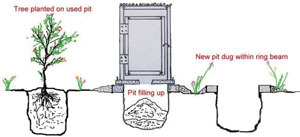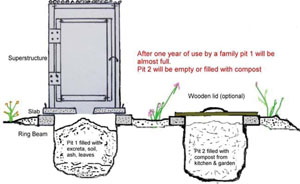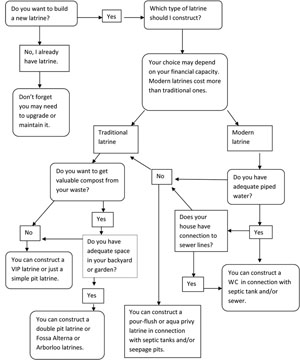Use 'Print preview' to check the number of pages and printer settings.
Print functionality varies between browsers.
Printable page generated Saturday, 22 November 2025, 2:42 PM
Hygiene and Environmental Health Module: 20. Latrine Construction
Study Session 20 Latrine Construction
Introduction
In Study Session 19, we described the various methods of liquid waste management and discussed the issues that need to be considered when choosing appropriate sanitation technologies. In most rural situations, a dry latrine of some sort will probably be the most appropriate technology to choose. This study session will provide some practical details about the different types of latrine and how they should be constructed.
It should be noted that we do not have space here to include all the technical construction details. This is not a construction manual. Although the techniques described are not complicated, the latrines need to be designed and built in the correct way and you may need to seek out further details or expert advice if you wish to promote the installation of some of these different types of latrine. Latrine Technology Options, published by the Federal Ministry of Health, is a useful reference.
Learning Outcomes for Study Session 20
When you have studied this session, you should be able to:
20.1 Define and correctly use the key words printed in bold. (SAQ 20.1)
20.2 Describe the main features of simple pit latrines and VIP latrines. (SAQs 20.2 and 20.3)
20.3 Describe ecological sanitation systems. (SAQ 20.1)
20.4 Describe standard construction techniques for latrines with handwashing facilities. (SAQs 20.2 and 20.4)
20.5 Help families select appropriate sanitation technologies. (SAQ 20.5)
20.1 Types of latrine
In Study Session 19, sanitation facilities were classified as improved or unimproved, and alternatively as wet or dry systems.
Three types of dry sanitation technology were included in the list of improved facilities in Study Session 19. What were they?
Pit latrine with slab, ventilated improved pit (VIP) latrine and ecological sanitation.
Pit latrines are basic structures that can be adapted easily into different types of latrines such as VIP latrines and ecological sanitation systems. These other latrines share many common features of simple pit latrines; therefore, focusing first on pit latrines will help you to understand the other sanitation technologies as well.
20.2 Pit latrine with slab
Pit latrines are the simplest form of dry latrine. They consist of a pit dug in the ground and a cover slab or floor above the hole (Figure 20.1). Pit latrines must have a cleanable cover slab in order to be considered as improved sanitation systems. The excreta (both faeces and urine) drop through the hole to enter the dry pit. Pit latrines should be constructed on a slight mound so they are higher than the surrounding ground and water at the surface will flow away from the hole. They should also have a lid that can be placed over the hole to reduce problems with flies and odours. They may have a squat pan or a raised footrest to make using the latrine more convenient. The pit is often lined but the bottom remains open, allowing the liquid to drain into the soil and leaving the solids behind.
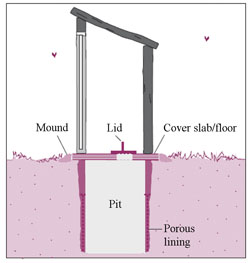
Pit latrines should also have an upper part, called the superstructure, to provide protection from the rain and sun, and privacy and comfort for the user (Figure 20.2).
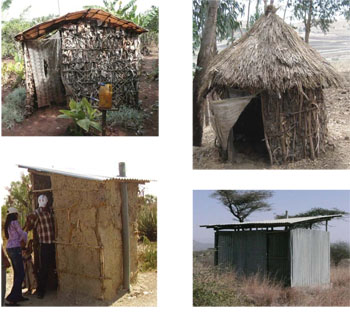
Pit latrines can have a single pit or double pit. In double pits, while one is filling with excreta, the second pit remains out of service. When the first pit is filled with excreta up to about 50 cm below the slab, it is taken out of use and the remaining space is filled with grass and vegetation materials that can be composted. You then use the second pit until that is full. Meanwhile, the first pit will stay sealed for a period of 6–9 months, during which time the waste will decompose and any pathogenic microorganisms will die. After this period, the material (humus soil) in the first pit can be taken out manually. (Humus or humic is used to describe organic matter that has been stabilised by decomposition processes.) It is safe to handle and readily used as fertiliser in agriculture or can be disposed of safely. This is the principle of ecological sanitation that is described further in Section 20.4.
20.2.1 Advantages and disadvantages of pit latrines
In general, pit latrines with a slab are effective sanitation systems because they isolate human excreta from the surrounding environment and prevent the transmission of faeco-orally transmitted diseases. They also have other advantages:
- They do not require water so are appropriate in areas where there is no adequate water supply.
- Squatting is normal to many people and thus is acceptable to users.
- Alternating double pits will allow the excreta to drain, degrade and transform into a nutrient-rich, safe humic material that can be used to improve soils.
- They avoid contamination of surface water and top soil if properly installed and maintained.
- They can be constructed with minimum cost using local material and local skills.
- The presence of properly constructed slabs will allow easy cleaning and avoid flies and unsightliness.
However, pit latrines are not without limitations. There may be a foul odour from the pit and they can be a favourable place for the breeding of flies and mosquitoes. With single pits, a new pit needs to be dug every time one gets full. They can be susceptible to failure/overflowing during floods. Other disadvantages can be overcome by proper design, construction and usage. For example, if the superstructure is not properly constructed, it may discourage use of the latrine by family members. Children may be discouraged from using the latrine if the slab is not designed with them in mind and is too big for them. Use of excess water or less compostable materials for anal cleansing should be avoided because it may affect the decomposition rate of human excreta.
20.2.2 Siting, designing and constructing a pit latrine
The site of a latrine should preferably be in the backyard of the house and away from an alley in the village. It should not be nearer than 6 m or farther than 50 m from the house. The direction of the wind should be away from the main house. If there is a well in the compound, the latrine should be located as far away from it as possible on the downhill side to avoid possible seeping and contamination of groundwater. The faecal microorganisms may migrate from the pit through the soil, however, the degree that this happens varies with the type of soil, moisture levels and other environmental factors. It is, therefore, difficult to estimate the necessary distance between a pit and a water source, but 30–50 m is the recommended minimum, with an absolute minimum of 15 m.
The size of the pit depends on the number of people using it and the design period, i.e. the length of time before it is full. Typically, the pit should be at least 3 m deep for a family of five for a design period of three to five years. The diameter should be at least 1 m; up to 1.2 m diameter will make it easier to dig but if it exceeds 1.5 m there is an increased risk of collapse, especially in sandy soils.
As you may remember from Study Session 19, you need to consider the geology, soil type and topography (the slope of the land) when considering sanitation technologies. In flood-prone areas, it is advisable to raise the mound of the latrine and prepare diversion ditches around it. When the soil condition is rocky and it is impossible to dig a deep pit, the depth of the pit can be extended by building upwards with concrete rings or blocks. However, care must be taken to ensure the structure remains watertight. The level of the water table must also be taken into consideration. The pit must be entirely above the water table at all times of the year. If the water table is near the surface of the ground, the waste in the pit may contaminate the groundwater.
Lining the pit prevents it from collapsing and provides support to the superstructure. The pit lining material can be brick, rot-resistant timber, concrete, stones, or mortar plastered on to the soil. If the soil is stable (i.e. no sand or gravel deposits or loose organic materials), the whole pit need not be lined. The bottom of the pit should remain unlined to allow the percolation of liquids out of the pit.
The superstructure should be built using locally available materials. These may include a masonry wall made of cement blocks, bricks, or stone with cement or mud bindings; or a wooden structure covered with timber, bamboo, grass/thatch, sticks, leaves of banana or enset trees, or canvas made of sacks. However, the type of superstructure depends on several factors such as a household’s financial capacity, the availability of construction material locally, local customs and traditions, and the availability of skilled artisans.
Look again at Figure 20.2. What materials have been used for the different superstructures in these four pictures?
The latrine in the picture at top left has sticks with leaves for the walls and a plastic roof. The latrine at top right is made of sticks and grasses. At lower left, the latrine has walls of mud with a corrugated plastic or metal roof. The latrine at lower right is made of corrugated metal.
The cover slab needs to be strong and have a smooth surface so it can be cleaned easily. It may be made of concrete or termite- or rot-resistant timber, with or without stones and mud covering. Various designs of slab are used (Figure 20.3).
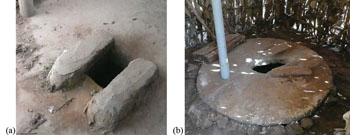
20.2.3 Maintenance of pit latrines
Pit latrines must be properly maintained to function properly. You should advise families to keep the squatting or standing surface clean and dry. This will help to prevent pathogen/disease transmission and limit odours.
If the pit has been dug to an appropriate size for the number of users, then it may never become full. The liquid will drain into the soil and the solid waste will slowly decompose so the volume remains stable.
20.3 Ventilated improved pit (VIP) latrine
The VIP latrine is an improvement over the simple dry pit latrine. The distinctive feature that gives the VIP latrine its name is the vent pipe installed into the pit, which is used to exhaust the foul odour from the pit and control flies (Figure 20.4). If you look back at the photos in this study session, you can see vent pipes in several of the latrines.
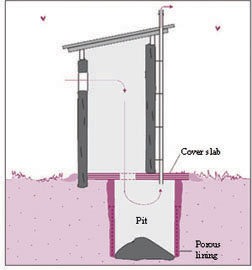
The principle is that a continuous flow of air comes in through the superstructure and enters the pit through the hole. This cold air will go down into the pit displacing (pushing up) the hot smelly air upward through the vent pipe. The other advantage of the vent is controlling flies. As we discussed earlier, dry pit latrines potentially serve as breeding places for flies. Newly-emerging adult flies will try to escape through the vent pipe because the pipe allows sunlight to enter into the pit and flies are photopositive (meaning they move towards light) by nature. A mesh screen tied at the top of the vent pipe will prevent flies from escaping to the outside of the latrine.
VIP latrines can have a single pit or double pit. They share the advantages of simple pit latrines with slabs described above but they also have unique advantages that improve on the limitations, namely, that flies and odours are significantly reduced. It should be noted, however, that the health risks from flies are not completely removed by ventilation.
20.3.1 Constructing a VIP latrine
As it is based on a simple pit latrine, we will discuss only the improved features of VIP latrines. The vent pipe should have an internal diameter of 110–150 mm and reach more than 300 mm above the highest point of the superstructure. The vent works better in windy areas but where there is not much wind its effectiveness can be improved by painting the pipe black. This makes the vent pipe warmer and the heat difference between the pit (cool) and the vent (warm) creates an updraft that pulls the air and odours up and out of the pit. To test the efficacy of the ventilation, a small, smoky fire can be lit in the pit; the smoke should be pulled up and out of the vent pipe and not remain in the pit or the superstructure. The mesh size of the fly screen must be large enough to prevent clogging with dust and allow air to circulate freely. Aluminum screens with a holesize of 1.2–1.5 mm have proved to be the most effective.
20.3.2 Maintenance of VIP latrines
The maintenance requirements are similar to simple latrines. In addition, dead flies, spider webs, dust and debris should be removed from the ventilation screen to ensure a good flow of air.
20.4 Ecological sanitation
Ecological sanitation, also known as ecosan, describes an approach to human waste management rather than a single method. In ecosan systems, human excreta is considered to be a resource, not waste. The principle is to make use of excreta by transforming it into an end product that can be used as a soil improver and fertiliser for agriculture. Ecological sanitation aims to decrease contamination of the environment caused by human excretion and to prevent faeco-orally transmitted diseases. An additional benefit of using waste in this way is that the amount of artificial fertiliser used in cultivation of fields is decreased. This saves money for the farmer and protects lakes and other water bodies from eutrophication caused by runoff of these additional fertilisers.
There are, however, some constraints for communities to consider before adopting the ecosan approach. Ecosan systems require a little more space than conventional latrines. At the end of the process the decomposed waste, known as compost or ecohumus, has to be dug out before it can be spread on the land. There may be a cultural taboo against handling of excreta, even though it should be more like soil than waste by this stage. Some people may be unwilling to use the crops and foods produced. Nonetheless, ecological sanitation is a more sustainable approach to waste management than other systems and should therefore be promoted as the preferred option. You may need to convince families that it is safe and has no negative health effects. Model families may be able to help if they demonstrate to others that the compost produced is safe and acceptable to use.
20.4.1 Arborloo – a single pit method
A simple form of ecological sanitation is the Arborloo (Figure 20.5). This consists of a single, unlined shallow pit with a portable ring beam (circular support), slab and superstructure. It is used like a normal latrine but with the regular addition of soil, wood ash and leaves. When it is full, it is covered with leaves and soil and a small tree is planted on top to grow in the compost. (The tree gives the system its name; ‘arbor’ is Latin for ‘tree’.) Another pit is dug nearby and the whole structure is relocated over the new pit. No handling of the waste is required. If a fruit tree or other useful variety is grown there is the added benefit of food or income.
20.4.2 Fossa Alterna – a double pit method
The double pit latrine system described in Section 20.2 can be constructed to be an ecosan system. The alternating waterless double pit is also known as Fossa Alterna, which means alternate ditch. The physical structure is constructed in a similar way to a single pit latrine except that it has two pits and they are shallower than a normal pit with a maximum depth of 1.5 m. The slab and superstructure may be movable between the two pits (Figure 20.6) or may be a larger permanent structure that covers both pits.
Like the Arborloo, soil, wood ash, vegetable kitchen waste and leaves are added regularly. A small amount should be added after each defecation (not urination). This introduces necessary plant material to mix with the human waste and also adds a variety of organisms like worms, fungi and bacteria that help in the degradation process.
When the first pit is full, after about 12–24 months depending on the size of the pit and the number of users, everyone starts using the second pit instead. The first pit is covered and the material in it will degrade into a dry, earth-like mixture. This takes about 6–12 months. After this time, the composted mixture is dug out manually and can be used to spread on soil. It is important in the construction to make sure the slab is movable or has a manhole large enough to allow access to the pit for digging out. The health risk for the people who empty the compost is minimal if the pit has been left for over one year. However, good personal hygiene should always be promoted in activities related to sanitation.
20.5 Water carriage systems of human waste disposal
20.5.1 Cistern flush toilet
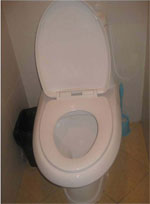
The cistern flush toilet, also known as a water closet or WC, is usually made of ceramic material (Figure 20.7). The flush toilet consists of two parts: a tank (cistern) that supplies flushwater for carrying away the excreta and a bowl into which the excreta are deposited. It also needs connection to constant running water and a discharge pipe to take the wastewater away to a sewer or septic tank. WCs are rarely found in rural households but are quite common in government offices, some schools and health facilities.
The attractive feature of the flush toilet is that it has a water seal to prevent odours from coming back up through the plumbing. A skilled plumber is needed to install a flush toilet. From the users’ perspective, it is a safe and comfortable toilet to use provided that it is kept clean, but the high capital cost for installation and the need for skilled personnel makes it not affordable by every family, especially those living in rural areas.
20.5.2 Pour-flush toilets
A pour-flush toilet is like a cistern flush toilet except that instead of the water coming from the cistern above, it is poured in by the user. When the water supply is not continuous, any cistern flush toilet can become a pour-flush toilet. Water is simply poured into the bowl manually from a bucket or a jug to flush the excreta; approximately 2–3 litres of water is usually sufficient. Pour-flush toilets share all the advantages of cistern flush toilets but use a lot less water. The wastewater should be disposed of to a septic tank or seepage pit, also known as a leach pit (Figure 20.8).
The pit will contain excreta, cleansing water and flush water. As this leaches from the pit and migrates through the soil, faecal organisms are removed. In some geological conditions, there is a risk of groundwater pollution; therefore, this method is not always recommended.
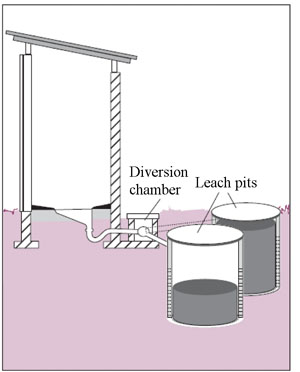
20.5.3 Aqua privy
The aqua privy is a single pit latrine which has a watertight pit filled with water. Excreta drops into the pit and wastewater is displaced into a storage chamber, a seepage pit or a sewer line. It needs to be topped up regularly, so a nearby water supply is required.
20.5.4 Urinals
Urinals, used by men and boys, are only used for collecting urine. Urinals are either wall-mounted units or a drainage channel constructed on the floor in connection with the wall. Most urinals use water to flush although waterless urinals are now becoming popular. In public places and schools, urinals for men and boys help to keep toilets cleaner and decrease the demand for more toilet-seats.
20.6 Handwashing facilities
Every latrine or toilet must have handwashing facilities. As you know, hygiene is an essential component of health promotion and one of the critical times for handwashing is after visiting the toilet. A latrine without a proper handwashing facility will not serve its ultimate objective of disease prevention.
If there is no running water, handwashing stations can be made using jerrycans (Figure 20.9), tin cans, wooden bowls, or pottery depending on the local culture and custom of your community. Simple devices can be made using very basic materials (Figure 20.10).

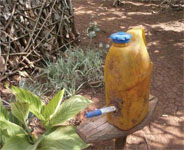
To make a handwashing station similar to the one in Figure 20.10, follow these easy steps: (Source: adapted from USAID/HIP, 2007)
- Find a plastic container of approximately 5 litres capacity. A jerrycan or gourd can also be used.
- You will also need a hollow tube to make the spout. You can use a pen casing (as shown in Figure 20.10), a pawpaw stem or anything that is hollow. You will also need a sharp knife, nail or screwdriver.
- Decide on the design of your handwashing station before you begin working. Will your container sit on a platform or hang and tip?
- Wash the container and tube so they are free from visible dirt.
- Heat the knife, nail or screwdriver to make piercing a hole for the tube easier.
- Make a small hole for inserting the tube. Make it as low on the container as you can, about 2 cm (two finger widths) from the bottom. Be careful to make it smaller than the tube.
- Slowly and carefully push the tube into the hole. Be very careful not to push the hole so big that it leaks.
- Test the water flow:
- When using a plastic bottle: water is delivered when the bottle cap is unscrewed and stops flowing when the cap is tightly shut.
- When using a jerrycan or gourd: water comes out when the cap on the pen or plug in the container is removed. If you don’t have the original pen cap, find an old stick to ‘plug’ the flow.
Finally, set up the station right by the latrine by hanging it from a string around the neck, or setting it on a stable platform. You should also provide soap or ash for washing.
20.7 Your role in latrine construction
Your role is to promote latrine construction by giving advice and encouragement to people in your community to install or improve sanitation systems. In Section 19.4 of Study Session 19 we discussed some of the general principles to be considered when choosing sanitation technologies. This study session has provided further details about the different types of latrine. Figure 20.11 is a decision tree that has been designed to help you answer questions from households such as ‘what type of latrine/toilet can I construct?’ Start with the question at the top left corner and follow the arrows according to the answers. Be aware this is only an outline guide that summarises the key points.
As part of the process of latrine construction, you can help develop skills in your local area. With the help of district health offices, you should be encouraging local artisans and entrepreneurs to create a sanitary service chain of, for example, prefabricated slabs. You can also promote training of local people on proper latrine construction techniques, especially for improved types of latrine. You can also assist with training of model family household members in your community. Although they may not be common in rural Ethiopia, you should also be familiar with the concepts in higher level sanitation facilities such as water carried systems because you may be involved in advising households that want to upgrade their facilities up the sanitation ladder, step by step. Whichever type of latrine is used, your role is to promote good sanitation and hygiene wherever possible.
Summary of Study Session 20
In Study Session 20, you have learned that:
- Pit latrines with slab, VIP latrines and ecological sanitation systems are all types of improved sanitation facility.
- Pit latrines consist of a pit, slab and superstructure. The slab is essential to separate waste from the people using it. The superstructure ensures privacy; it can be constructed of many different locally available materials.
- Latrines must be sited with due consideration of the type of rock/soil, the location of water sources, the location of houses and the wind direction.
- VIP latrines are better than simple pit latrines because the vent pipe reduces smells and flies.
- Ecological sanitation systems, also known as ecosan systems, have the added benefit of producing useful compost material that can be spread on fields as fertiliser.
- Arborloo, with one pit, and Fossa Alterna, with two pits, are two types of ecosan system.
- Water carriage systems such as WCs, pour-flush latrines and aqua privies have some advantages over dry systems but they require a regular water supply and are more expensive.
- Handwashing facilities are essential for use with all types of latrine. They can be easily constructed from simple materials.
- You can help families and others by providing advice on siting and choice of latrine.
Self-Assessment Questions (SAQs) for Study Session 20
Now that you have completed this study session, you can assess how well you have achieved its Learning Outcomes by answering these questions. Write your answers in your Study Diary and discuss them with your Tutor at the next Study Support Meeting. You can check your answers with the Notes on the Self-Assessment Questions at the end of this Module.
SAQ 20.1 (tests Learning Outcomes 20.1 and 20.3)
Explain the difference between an ecosan latrine and a standard pit latrine.
Answer
In an ecosan latrine, human waste is mixed with plant material, ash and vegetable waste so that when it has decomposed it produces a useful product. It converts the waste into a resource. The compost can be used for growing a tree in the Arborloo system or it can be dug out to be used to spread on fields as a fertiliser. This does not happen in a standard pit latrine, which simply contains the waste.
SAQ 20.2 (tests Learning Outcomes 20.2 and 20.4)
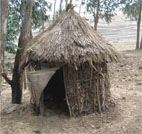
What improvements would you suggest to the latrine shown in Figure 20.12?
Answer
This latrine is very basic. It would be improved by the proper installation of a concrete slab over the pit. The slab should have a lid over the squat hole. It could also be improved by installing a vent pipe in the proper way to convert it into a VIP latrine. There should be a handwashing facility just outside the door.
SAQ 20.3 (tests Learning Outcome 20.2)
What are the potential risks posed to the environment in using dry pit latrines?
Answer
The liquid waste seeps out of pit latrines into the ground beneath. This could cause pollution of groundwater and surface water.
SAQ 20.4 (tests Learning Outcome 20.4)
List the materials you would need to make a simple device for handwashing.
Answer
The materials needed to make a handwashing device are a water container that can hold about 5 litres with a lid, a hollow tube of some sort for the spout, something sharp to make the hole with and something to stand or hang the container on. You will also need soap or ash for effective handwashing.
SAQ 20.5 (tests Learning Outcome 20.5)
Ato Tedila, a local farmer, consults you about building a latrine in the compound of his house. He is an open-minded man who is keen to improve life for his family. He has a wife and three young children and his elderly mother also lives with them. They get their water from a well in the compound. The area has a heavy soil and the rock below is impermeable.
- a.Which types of latrine are possible choices for him?
- b.Which types of latrine would you recommend, and why?
- c.What other advice would you give him about the location, design and construction of the latrine?
Answer
- a.Ato Tedila cannot install a water carriage system because he does not have a piped water supply; therefore, he has to install a pit latrine of some sort. The possible choices are a single pit latrine, a pit latrine with slab, a VIP latrine with slab, a double pit latrine or one of the ecosan systems, namely an Arborloo or a Fossa Alterna.
- b.You should not recommend a pit latrine without a slab because this does not provide adequate sanitation. The VIP latrine is preferable to a simple latrine, but an ecosan system would be better because this would produce a useful product as well as protecting the health of the family and the environment. You would need to ask Tedila about his attitude to using an ecological sanitation system and whether he would be willing to make use of the composted waste material. He is a farmer so he may be able to use it on his fields and he is open-minded so this system may be attractive to him. If he was reluctant to dig out the compost you could recommend the Arborloo system because that does not require handling; the tree is planted on top of the filled pit.
- c.You should advise him to consider the location of the pit. It must be at least 15 m away from his well and preferably a greater distance. It must also be at a lower level according to the slope of the land. He should also consider the wind direction and place the latrine downwind and at a convenient distance from the house. He would need to consider the design of the squat hole to ensure it is safe for his children and comfortable for his elderly mother. You could advise him about possible materials to be used for the superstructure and recommend what is available locally. You should also advise him to install a handwashing facility next to the latrine.
